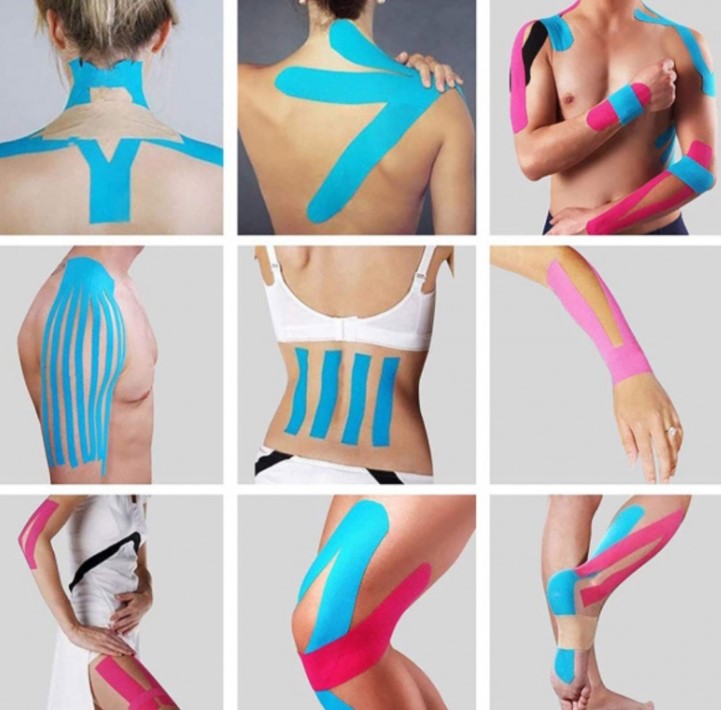BOURSESSENEGAL – Kinesiology tape has gained immense popularity among athletes, physical therapists, and fitness enthusiasts. This elastic therapeutic tape offers support and pain relief while allowing for full range of motion. In this guide, we’ll explore the benefits of kinesiology tape, its applications, and how it can enhance your performance. Understanding kinesiology tape will empower you to use it effectively, whether you’re recovering from an injury or aiming to improve your physical performance.
What is Kinesiology Tape?
A Brief Overview
Kinesiology tape is a flexible, elastic tape designed to support muscles and joints without restricting movement. Unlike traditional athletic tape, which immobilizes the area, kinesiology tape provides gentle support, allowing for greater mobility. Developed in the 1970s by Dr. Kenzo Kase, this innovative tape has become a staple in sports medicine and rehabilitation.
How It Works
Kinesiology tape works by mimicking the skin’s elasticity. When applied correctly, it lifts the skin slightly away from the underlying tissues. This lifting action can help reduce pressure on pain receptors, improve circulation, and promote healing.
Benefits of Kinesiology Tape
1. Pain Relief
One of the primary benefits of kinesiology tape is its ability to alleviate pain. By lifting the skin, it reduces pressure on the affected area, which can decrease discomfort. Many athletes find relief from muscle soreness and joint pain, enabling them to perform better.
2. Enhanced Performance
Kinesiology tape can improve athletic performance by providing support during physical activities. It stabilizes muscles and joints, allowing athletes to maintain proper form without compromising their range of motion. This support can lead to improved overall performance.
3. Injury Prevention
Using kinesiology tape as a preventive measure can help avoid injuries. By offering support to vulnerable areas, it encourages proper biomechanics during movement. Athletes often apply the tape before training or competition to safeguard against potential strains or sprains.
4. Faster Recovery
After an injury, kinesiology tape can facilitate a quicker recovery process. It enhances blood flow to the injured area, promoting healing. Many physical therapists incorporate kinesiology tape into their rehabilitation programs to help patients recover more effectively.
Applications of Kinesiology Tape
1. Sports Injuries
Kinesiology is widely used to treat various sports-related injuries, such as:
- Sprains: Whether it’s an ankle or wrist sprain, kinesiology can provide stability.
- Tendonitis: The tape supports inflamed tendons, reducing strain during movement.
- Muscle Strains: It aids in recovery and provides support to strained muscles.
2. Post-Surgery Recovery
After surgery, kinesiology can assist in rehabilitation. It can help stabilize the surgical site while allowing for gentle movement. Many patients report improved comfort and mobility when using the tape during recovery.
3. General Pain Management
Beyond athletic use, kinesiology can benefit anyone experiencing pain. It can help manage conditions like back pain, neck pain, and arthritis. By applying the tape strategically, individuals can experience relief from chronic discomfort.
How to Apply Kinesiology Tape
1. Preparing the Area
Before applying kinesiology , ensure that the skin is clean and dry. Shaving the area can improve adhesion, especially for individuals with body hair.
2. Measuring and Cutting the Tape
Cut a piece of kinesiology to the desired length, typically 10 to 15 inches. Round the edges of the tape to prevent peeling.
3. Application Techniques
There are various techniques for applying kinesiology , depending on the area and the desired effect:
A. Muscle Support
To support a muscle, start by anchoring the tape on one end and stretch it along the muscle belly. Apply the tape with light tension, leaving the ends unstretched.
B. Joint Support
For joint support, apply the tape around the joint. Create an “X” shape over the affected area for stability.
C. Pain Relief
For pain relief, use the “I” or “Y” strip method. Anchor the tape at the pain site, then apply with slight tension, extending it to cover the surrounding area.
4. Monitoring the Application
After applying kinesiology , monitor the area for any signs of irritation or discomfort. If any issues arise, remove the tape and consult a professional.
Tips for Using Kinesiology Tape
1. Choose the Right Tape
Not all kinesiology are created equal. Look for high-quality, hypoallergenic options to avoid skin irritation. Brands with a strong reputation often provide better adhesion and durability.
2. Practice Makes Perfect
If you’re new to using kinesiology consider practicing your application techniques. Watching tutorial videos can help you become more proficient and confident in your application skills.
3. Combine with Other Treatments
For optimal results, combine kinesiology with other treatments, such as physical therapy or massage. This holistic approach can enhance recovery and overall well-being.
Common Misconceptions About Kinesiology Tape
1. It’s a Cure-All
While kinesiology offers numerous benefits, it’s not a standalone cure for injuries or pain. It’s best used as part of a comprehensive treatment plan that includes rest, rehabilitation, and professional guidance.
2. It Can Be Applied Anywhere
While kinesiology is versatile, improper application can lead to ineffective results. Understanding anatomy and proper techniques is essential for effective use.
Conclusion: The Value of Kinesiology Tape
Kinesiology serves as a powerful tool for athletes and individuals seeking pain relief and enhanced performance. Understanding its benefits, applications, and proper techniques can help you make the most of this innovative product.
Take Action
If you’re considering kinesiology , consult a healthcare professional for guidance on proper application and use. This will ensure that you achieve the best results tailored to your specific needs.
Empower Yourself
Embrace the benefits of kinesiology in your fitness journey. By integrating it into your routine, you can enhance performance, prevent injuries, and support recovery. Make informed choices and take charge of your health and well-being!
REFERENCE : taman77



